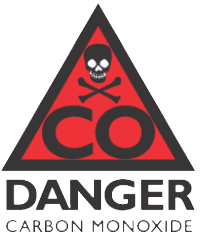

Carbon Monoxide (CO) Safety
Carbon monoxide (CO) is the most commonly encountered and pervasive poison in our environment. Each year thousands of people seek medical attention or lose days of normal activity and more than 500 people die through unintentional exposure to carbon monoxide. Flu and bad cold symptoms such as headaches, nausea, pains, and mental confusion are sometimes caused by carbon monoxide gas in your home.
You probably know that if you "smell gas", you are not smelling carbon monoxide which is odorless and colorless. If you do smell gas, you should immediately shut down your gas appliances and call for help. Gas that you can smell is usually the gas from your propane tank. There is a special chemical put into propane gas to make it smell like rotten eggs so you will notice it if there is a leak. If this gas were to build up in your home, it could explode and destroy your home.
The other common dangerous gas, carbon monoxide, can be produced inside a home containing appliances which burn carbon-containing fuels including coal, wood, charcoal, natural or propane gas, kerosene and fuel oil. It is produced by incomplete combustion or poor ventilation of fuel-burning appliances such as oil or gas furnaces, gas cooking appliances, water heaters, room heaters (such as Monitor® and Toyo® Heaters), fireplaces, wood stoves, generators and any apparatus that burns fuel.
Carbon monoxide is the same toxic gas that comes out of the tail pipe of your car if you leave it in a closed garage with the engine running. Carbon monoxide is an odorless, colorless gas that interferes with the delivery of oxygen by the blood to the rest of the body.
Remember that smoke detectors do not detect carbon monoxide, just as carbon monoxide detectors do not detect smoke or products of combustion. There are now some detectors on the market that do detect both smoke and carbon monoxide but they are specifically advertised as combination units.
State and city laws require carbon monoxide detector installation per the manufacturer’s recommendations.